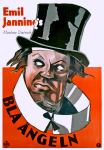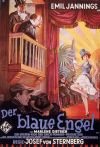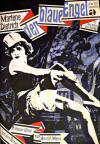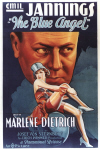|

 There is a rumble of premonition in the fact
that the first talking film to make itself heard in this volume and
therefore to lead to the sound parade is Josef von Sternberg's The Blue
Angel, made in Germany in 1929. For above and beyond this
picture's being a mordant work of cinema art and a surprisingly early
example of effective wedding of picture and sound, it marks the first
all-out screen appearance of a kind of woman and a quality of sex that have
become progressively more insistent in the culture of talking films. There is a rumble of premonition in the fact
that the first talking film to make itself heard in this volume and
therefore to lead to the sound parade is Josef von Sternberg's The Blue
Angel, made in Germany in 1929. For above and beyond this
picture's being a mordant work of cinema art and a surprisingly early
example of effective wedding of picture and sound, it marks the first
all-out screen appearance of a kind of woman and a quality of sex that have
become progressively more insistent in the culture of talking films.
The woman that Marlene Dietrich exudes in this
dark, degenerate tale of the destruction of a German schoolmaster by a
faithless cabaret girl is so far advanced beyond the limits of the sleek,
husband-stealing vamps, the poignant, self-sacrificing mistresses and the
shimmying bowlfuls of "it" that so inadequately stated the attraction of
women for men in silent films, it's no wonder she caused a world sensation,
launched Miss Dietrich on a fabulous career and became, as it were, the
grandmother of a whole slew of notable screen sluts.
Some critics say The Blue Angel is
important primarily because it so presciently shows the immaturity and
sadism of the German middle class. It does this, beyond any question. In its
singular contemplation of the sudden disintegration of a pillar of bourgeois
society under the quick, corrosive influence of a strong application of
gutter sex, it starkly reveals the imperfection and fraudulence of the
facade of middle-class decency and discipline that is ponderous hero
represents. It sourly suggests the soggy culture out of which Nazism oozed.
And in the sadistic frenzy of the schoolboys to torment and destroy their
hated teacher after they have witnessed his weakness for the cabaret girl,
we may spot the incipient viciousness of later Hitler Youth.
But I find The Blue Angel most engrossing
because of the opening it makes upon the whole darksome, subterranean area
of psychoneurotic sex. Where the custom in silent pictures was simply to
treat the primal urge as a powerful but usually unholy and sinful appetite
that overwhelms men and women by its sheer physical rush and urgency, the
revelation in this picture is a sickly image of sex as a passion mixed up
with deep obsessions to dominate and get revenge. And where the evil of it
in the silents was mainly its immorality, the evil of it in The Blue Angel
is its corruption into a social disease that infects the aggressions of
people and causes them to act in debased and vicious ways.
The great Professor Rath, its stern protagonist,
is no more than a pretty brute whose badgering and bullying of his teenage
pupils is apparently his only means of releasing his inhibitions and
rewarding his stuffy bachelorhood. Thus it would seem a mere extension
of his desire to rule the boys that causes him to trail some of them to
The Blue Angel, a low-class cabaret, when he discovers they are going
there to ogle a female entertainer whose photograph he has snatched from one
of them. And likewise it would seem but a fervor to show his
boastful authority that first sends him to the dressing room of Lola, the
sultry singing star.
But, of course, it is the pull of voyeurism and
a resentment of her attractiveness that hauls him into her presence,
and it is desire to vaunt his masculine command, as much as it is lust for
fornication, that makes him fall for her lures to go to bed. Likewise,
it is h is ignominy, rather than any vestige of physical desire, that keeps
him attached to the woman after she has deceived and degraded him.
Similarly,
the basic urge in Lola, this insolent cabaret girl with the long legs, the
bare thighs, the garters, the provocatively ornamented crotch, the
smoldering eyes, the moistening armpits and the husky voice that sings
Falling in Love Again, is not to enjoy
coition. It is to vanquish and debase this stupid man who has dared to
intrude himself upon her with his air of superiority. It is the urge to take
vengeance upon him, which is the usual latent urge of prostitutes and, in
this particular case, to show contempt for the smug middle class he
represents.
These strange and ugly intimations which creep
out like worms in the film were a new kind of Freudian dissection of human
behavior when they were first shown on the screen. They still stand as
startling revelation in the overworked sex-drama genre.

_NRFPT_01_small.jpg) The Blue Angel was made by Sternberg at the
personal and urgent request of Emil Jannings, the distinguished German
actor, whom he had directed in Hollywood in
The Last Command (1928). Sternberg was a young American director who, in four years and nine silent
films, had advanced himself from the obscurity of a cutter to the gaudy
distinction of being the most aggressive enfant terrible (outside of Erich
von Stroheim) in American films. Although there had been some friction
between him and Jannings while they were making The Last Command, the famous
actor apparently trusted the director enough to seek his help when he went
back to Berlin and got ready to make his first plunge into the uncertain
realm of the talking film. The Blue Angel was made by Sternberg at the
personal and urgent request of Emil Jannings, the distinguished German
actor, whom he had directed in Hollywood in
The Last Command (1928). Sternberg was a young American director who, in four years and nine silent
films, had advanced himself from the obscurity of a cutter to the gaudy
distinction of being the most aggressive enfant terrible (outside of Erich
von Stroheim) in American films. Although there had been some friction
between him and Jannings while they were making The Last Command, the famous
actor apparently trusted the director enough to seek his help when he went
back to Berlin and got ready to make his first plunge into the uncertain
realm of the talking film.
For this initial venture, which was to be done
in German, of course (with, as it turned out in production, an English
version shot simultaneously), Jannings chose a novel, Professor Unrat, by
Heinrich Mann. It was a story of an eminent school teacher who lost his
position and caste when he married a demimonde singer and thereafter
disgraced himself in gambling and cheap politics. It was a bitter
arraignment of society at the time it was published, 1905.
Evidently Jannings chose it because it followed
the general line of the kind of stories in which he had been popular since
his brilliant appearance in F. W. Murnau's The Last Laugh (1924).
These were stories of fallen idols—men of substance and authority who, for
one reason or another (usually women), were reduced to ruin and shame.
In The Last Laugh, he was a hotel doorman who got drunk and lost his job.
In E. A. Dupont's superb Variety (1925), he was a stellar trapeze performer
who succumbed to jealousy. And he likewise was several sorts of failures in
the silent films he did in Hollywood—The Way of All Flesh (1927),
The
Patriot (1928), Sins of the Fathers (1929) and
The Last Command.
With Mann's complete endorsement and the nominal
collaborative help of three German writers, who Sternberg maintains in his
amusing autobiography, Fun in a Chinese Laundry, had virtually no hand in
it, the protean director prepared a screenplay which departed considerably
from Mann's original story. His changes were mainly in the cutting of
the latter part, updating it and reshaping the role of the girl.
Of major importance, as a consequence, was the
choice of an actress to play this role, a subtly corrosive creature who is
the deus ex machina. Sternberg describes with zest and humor the
circumstances under which he found an undistinguished actress who was then
in a play in Berlin and perceived her exquisite possibilities, despite their
complete obscurity to Jannings and everyone else. This may be. Erich Pommer,
the producer of The Blue Angel, once told me that Sternberg tried at
first to get a prominent German actress, Greta Massine, to play the crucial
role. When he couldn't get her, he
fretfully settled for this odd and unpromising girl, whose name was
Marlene
Dietrich and who had sung in cabarets. There is no point in quibbling
about it. The important thing is that Sternberg did pick Miss Dietrich
to play Lola and got a famous performance from her. It is not to take one
whit from his credit or from Jannings' to say that it is the aura exuded by
Miss Dietrich that gives this film its unique cachet.
Jannings is fine, beyond question, and his
powerful projection of Rath provides the dramatic provocation for the subtle
reactions of the girl. His deft establishment of the teacher in the opening
scenes—with his loftiness toward his landlady when she brings his breakfast
to his rooms, his arrogance toward his pupils, the way he domineers them
(especially the more timid and toadying), the way he wipes his glasses,
blows his nose, struts his command of English by speaking Hamlet's "To be or
not to be" soliloquy—provides an immediate and repugnant indication of a
bloated egotist.

 And it is he who propels the drama forward with
the obtuseness of a charging bull, as he lunges for the raw temptations that
Lola so deliberately waves, rushes for her sly seductions, puts himself in
the way of being speared. His brutish reaction to the business of her
tossing her panties in his face the time he first goes to berate her in her
smoky dressing room is like the first arrogant, contemptuous tangle of a
bull with a fluttering cape. He snorts at the miserable insult, but he
returns
the next night for more. (Incidentally, Sternberg's staging of this
scene in the dressing room is so cumulative
of detail, so suggestive of closeness and heat, one practically experiences
with the teacher the tousled garment's odor and warmth.) And it is he who propels the drama forward with
the obtuseness of a charging bull, as he lunges for the raw temptations that
Lola so deliberately waves, rushes for her sly seductions, puts himself in
the way of being speared. His brutish reaction to the business of her
tossing her panties in his face the time he first goes to berate her in her
smoky dressing room is like the first arrogant, contemptuous tangle of a
bull with a fluttering cape. He snorts at the miserable insult, but he
returns
the next night for more. (Incidentally, Sternberg's staging of this
scene in the dressing room is so cumulative
of detail, so suggestive of closeness and heat, one practically experiences
with the teacher the tousled garment's odor and warmth.)
Going on, Jannings' truculent performance of
Rath's bullheaded conceit when he is got drunk and falsely adulated by the
manager of the cabaret is vividly illustrative of his bovine plunging toward
doom. So is his dudgeon toward the school's headmaster when he is
censured for the scandalous thing he has done and pugnaciously accepts his
dismissal, or his fatuous responses to the flattery of Lola's associates
when they get him to crow like a cock at the wedding night. In
every respect, Jannings gives us an excruciating understanding of vanity,
lust and brute aggression that drives this man to his ruin. And he
finally presents a haunting picture of the last stage of Rath's decay in a
fit of maniacal cock-crowing on the cabaret's smoky stage before an audience
of his former pupils who have come to hoot at him.
But the air of evil and corruption that wafts so
heavily through this film comes from the sultriness of Lola, from the
intensity with which she is played. How much of this is Sternberg, his
sense of the mechanics of a slut and his skillfulness in surrounding such a
creature with a noxiously steamy atmosphere, and how much of it is Miss
Dietrich is hard to analyze. Sternberg suggests she was the puppet,
that he manipulated the strings.
Certainly he was the master who had her do such
impertinently obscene things as the business of tossing the panties, grossly
spitting into her mascara box, dropping cigarettes under her dressing table
and making Rath get down and pick them up so that he will be within inches
of her bare legs and her contiguous erogenous zone. It was Sternberg
who gave her the cruel line, "You've come back; they always do," when the
ponderously proud schoolmaster returns to her
dressing room. And it was he who directed Lola's sudden and viciously
autocratic switch from seductress to
commanding virago on their fatal wedding night.
But
it is Miss Dietrich's own magnetism, her weird way of sinking her eyes
behind an enigmatic curtain, her ability to blend just the right tones of
come-hither and go-to-hell in that
Falling in Love Again song
that put individuality into the character the director shaped for her.
It is notable that Sternberg does not give us
any scenes of Rath and Lola making love, none of the sort of erotic
acrobatics that have shown up in later sex-charged films. This is
tremendously important, for it is all too suggestively implied in the few
shots he shows of the teacher fumbling clumsily and grossly with the slut
that any sex act between them would be disgustingly callow and crude,
totally without pleasure for either of them. This leads us back to the
premise that it is sex in
its more neurotic form that is the essence of this picture. It
is the lust-bloated arrogance of a man who thinks he can impose his
domination and his whole stuffy, sterile way of life simply by having a
woman go to bed with him.
The clue to this fatuous self-deception is the
early attitude of Rath that he can have relations with Lola in the
conventions of the hide-bound middle class. When he wakes up in the
morning after his first night with her in her room, he has the indolent air
of a burgher after a stodgy rut with his frau. Likewise, he is deluded
when the manager of the Blue Angel boasts that his own special skill as a
magician puts him in the professorial class. Rath actually thinks his
stuffy status as a "herr
professor" is looked up to in this place. And he falls for the mocking
deception of Lola wearing a proper bridal gown for their obscenely vulgar
wedding. He still thinks he has conquered her.
_NRFPT_02_small.jpg) Thus the crux of the drama is the explosion of
this ridiculous conceit with the denouement of Lola's cruel perversion of
the purpose of sex. Suddenly and shockingly she shows Rath on their
wedding night that her seeming interest in him was but means to delude and
dominate. By making him pick up the bundle of lewd photographs of her
that he has spilled on the floor in indignation, she drives home the
devastating point that her sex is but an article in commerce and she uses it
as Thus the crux of the drama is the explosion of
this ridiculous conceit with the denouement of Lola's cruel perversion of
the purpose of sex. Suddenly and shockingly she shows Rath on their
wedding night that her seeming interest in him was but means to delude and
dominate. By making him pick up the bundle of lewd photographs of her
that he has spilled on the floor in indignation, she drives home the
devastating point that her sex is but an article in commerce and she uses it
as
she will. From his smug and smiling contentment, shown in the way he
smokes a fat cigar, he is suddenly dumped into a strange state of shock and
bewilderment. The flimsy props of his illusions are knocked out from
under him, and he finds himself stricken and helpless in an alien and
hostile milieu.
From here on, the morbid demonstration is the
sucking of this brutally deflated man into the maw of the vulgar environment
that Lola and the Blue Angel exploit—the environment of common, sex-starved
people gorging sausages, swilling beer and ogling the fat, concupiscent
women who rouse their animal appetites. It is an environment from
which the broken bourgeois ironically crawls at the end to die at his desk
in the schoolroom from which he detached himself so arrogantly.
This
being an early talking picture, it is interesting to see how economical
Sternberg is with talk. He packs some essential information and
personality into the dialogue, which is as it should be, and he develops a
great deal of stimulation with Lola's naturally included song. But
most of his best communication of character and atmosphere come in the
pictorial presentation that is done with silent techniques. So able is
Sternberg with details, so graphically does he describe the setting of
The Blue Angel, its personnel and its clientele, that one can almost
sense the body odors, the stink of stale beer
and cheap perfume. It is as though he has commanded in this picture
not only the dimension of sound but that of smell. This is one of the
things about The Blue Angel that makes it an extraordinary film.
Significant and premonitory is the fact that
Lola, for all her perversity, is still a provocative creature when we last
see her in the company of a handsome new actor. She is unloving and
self-serving, but she has that kind of arrogant allure that makes her the
secret envy of women and a vicarious challenge to men.
It was this quality that Sternberg tried to
carry on in the series of films that he made with a glamorized Miss Dietrich
in Hollywood during the next several years. The first of the lot,
Morocco, which has Gary Cooper as co-star, was released in
America in 1930, ahead of The Blue Angel in fact. It is the
best of the Hollywood series, but neither Sternberg nor Miss Dietrich ever
again reached, together or separately, the level of this ground-breaking
classic German film. |
